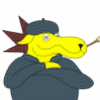HOME | DD
 AlphaX9 — Pronghorse
AlphaX9 — Pronghorse

#speculativeevolution #xenocene #speculativezoology
Published: 2020-07-01 15:41:17 +0000 UTC; Views: 3224; Favourites: 77; Downloads: 9
Redirect to original
Description
PronghorseScientific name: Neoantilocapra novicephalus
Height: 5 feet
Weight: 300-450 ibs
Habitat: temperate grasslands
Region: North America
Evolved from: Pronghorn
Lifespan: 20 years
Despite being the only representative left, the pronghorn was able to dodge the 6th mass extinction event unscathed. Since then, they’ve diversified fairly after man’s disappearance and have evolved into several specialized forms adapted to open environments. Even though predatory rats and mustelids are not fast enough to catch up with them in a chase, the Flash foxes on the other hand can. Originally from Eurasia, a type of canid descended from the red fox have evolved into a cusorial or cheetah like predator some time ago during the early Tabeocene. With a new predator to worry about, a population of pronghorns took what they already had and modified them even further to combat their new predator. They grew in size comparable to today’s elks, the horns became more elaborate in order to defend themselves in close quarters, and the skull has elongated to such a degree that they now look kinda cartoony. Enter the Pronghorse. One of the several species of grazing animals descended from the pronghorns. They still fill the same ecological niche that they’ve always filled from the beginning, but with a new predator to deal with; they’ve evolved an extremely long head so that they can spot predators even while grazing in tall grass. Because of the size increase, the Pronghorse is no longer able to run at neck breaking speeds like their ancestors (only being able to run up to 50 mph), but the greater size and crazy horns does create a form of protection from the flash foxes.
Both males and females possess horns, but males (like the one shown above) has the most elaborate ones. With the original pair forking out in the back of the head and a smaller peculiar pair which grows in front of the eyes. Besides the practical use of self defense, the Pronghorse also uses its horns for courtship purposes. During the mating season which usually occurs during the fall and winter, males would buttheads and clash their horns with each other to show dominance. Herds are largely female with males spending their time alone or in a bachelor pair. When a male Pronghorse reaches the age of 2, they’re kicked out from the herd and must fend for themselves from here on out. But because of their size and temperament, predators tend to not target them (unless they got injured).
In terms of habitat, they’re found all throughout the temperate plains and are the largest of the 2 species. With a slightly smaller species being found in the tropical grasslands farther south.
Commission done by Sheather888



















